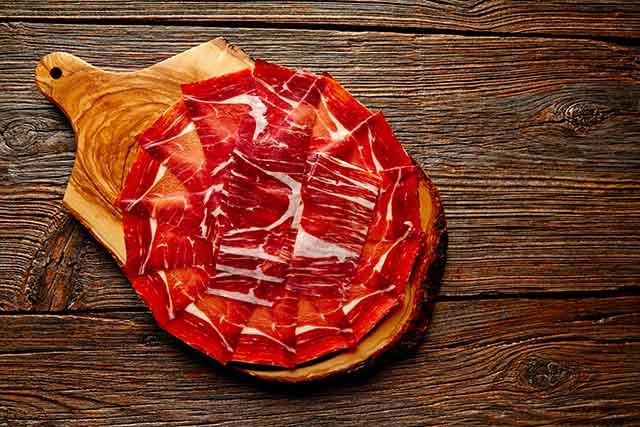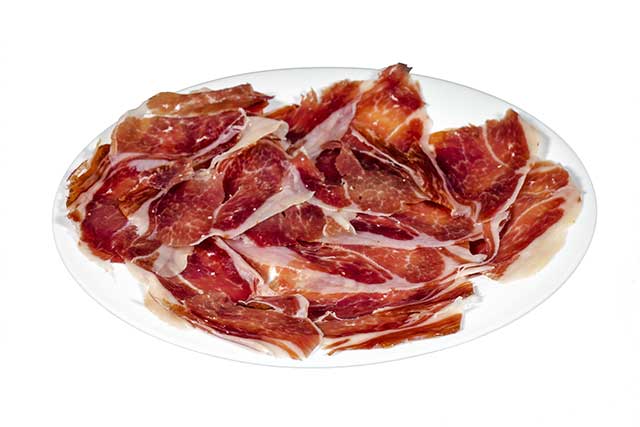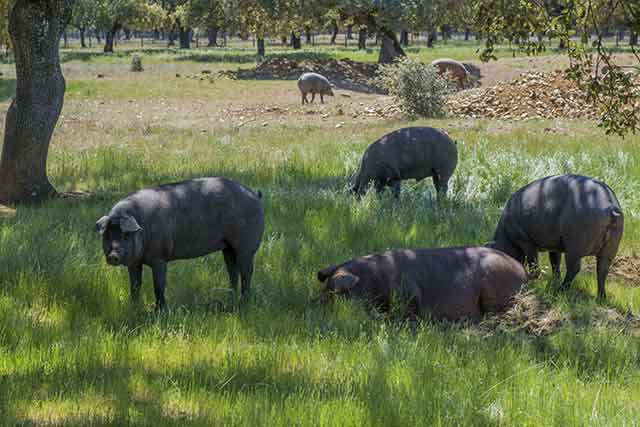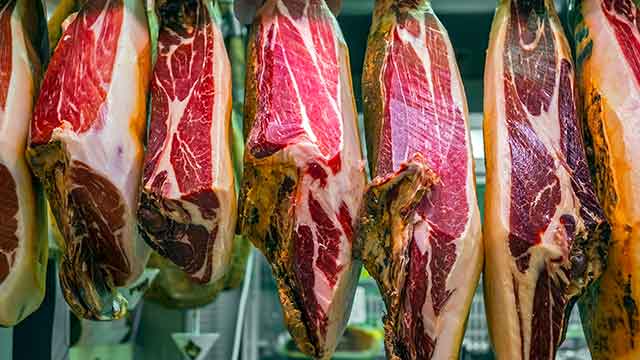What Is Jamon? A Complete Guide To the Spanish Ham
Jamón is a famous Spanish ham that enjoys popularity around the world.
There are many different types of jamón, but the most famous two are jamón ibérico and jamón serrano.
In this article, we look at the production process of jamón, the ingredient profile, how the different varieties differ, and the nutritional information.
What Is Jamón?

Jamón is a type of cured meat that originates in Spain. In other words; the meat is uncooked and preserved by traditional salting methods.
Depending upon the specific variety, the curing process can last for upward of three years.
The English translation of jamón is “ham,” but in Spain, jamón refers only to cured meat from the hind legs of a pig.
Curing jamón has been a traditional way to preserve meat in Europe since before the advent of refrigeration.
The first recorded written references of jamón go back to the days of the Roman Empire (1).
Also, the taste of jamón can vary depending on the variety, but all types have an intense meaty (and salty) flavor.
Jamón is sold in thin slices, similar to cured meats like prosciutto and coppa. Jamón pairs well with cheese, olives, and other cured meats.
Jamón vs. Prosciutto
Many people may wonder about the differences between jamón and prosciutto, which is a popular Italian cured meat.
In truth, the two are relatively similar.
While both foods look alike and come from pork legs, there are some key differences;
- Jamón tends to have a longer curing time than prosciutto. For instance, jamón ibérico has a minimum curing time of 24 months, whereas this duration is a minimum of 12 months for prosciutto. This extra time gives jamón a stronger and more intense flavor.
- The texture of jamón is much thicker and firmer than prosciutto, which tends to be quite soft and cut into thinner slices.
Types of Jamón
There are many different regional varieties of jamón, but the two primary types are jamón ibérico and jamón serrano.
However, there are some key differences between the two.
Jamón Serrano

Most jamón products from Spain are varieties of jamón serrano.
The pork used to make jamón serrano can come from any Spanish pig except for black Iberian pigs, which are used solely for jamón ibérico.
Common label names for jamón serrano include jamón curado, jamón extra, and jamón reserva.
Ingredients
- Pork leg
- Salt
Traditionally, jamón serrano uses only two ingredients; pork and salt.
However, some producers now use preservatives, such as sodium nitrate and potassium nitrate (2).
The reason for the use of these preservatives is first to prevent bacterial spoilage of the meat better (3).
Additionally, nitrates give food a more distinct red/pink color, which can make the meat more attractive.
Production
The production of jamón serrano involves a dry-curing process that ranges from six to eighteen months (4);
- Firstly, the cut pork leg meat is fully covered with salt and then left for 7-10 days. During this time, the meat stays in a temperature-controlled room at 0-3°C (32-37°F) with a humidity of 85-95%.
- After this salting period, the jamón is rinsed with water. Once thoroughly cleaned, the meat is left to rest at a temperature between 3-6°C (37-43°F) with a humidity of 80-90%.
- The meat spends approximately one to two months in this cold storage. Following this, the next step is a drying room which has a temperature somewhere between 15-30°C (59-86°F).
- The ham spends 6-12 months in this drying room hanging from the ceiling. As time passes, the meat develops deeper flavors and slowly dries as it loses water. Sometimes, the curing time is extended to produce jamón serrano aged for 18 months.
Nutrition Facts
The table below shows the basic nutrition profile for 100 grams of an authentic Spanish jamón serrano. The source of the nutrition data is the CRDB database (5);
| Calories/Nutrient | Amount |
|---|---|
| Calories | 250 kcal |
| Carbohydrate | 0 g |
| Fat | 16.1 g |
| Saturated Fat | 3.57 g |
| Protein | 28.6 g |
As shown, serrano provides a moderate amount of fat, and it is very high in protein.
Jamón Ibérico

Compared to jamón serrano, there are some major differences in the production of jamón ibérico.
Any jamón wishing to bear the name ‘ibérico’ must follow the rules below;
- Ibérico must be produced using pork from black Iberian pigs. These pigs tend to produce meat that is higher in fat than regular pigs.
- The higher grades of jamón ibérico must come from free-range/pastured pigs fed a strict and specific diet.
- Unlike serrano, jamón ibérico must have a curing process that lasts for at least two years.
- Specific stipulations need to be met to gain a ‘Denominación de Origin’ (certified origin) designation. Most importantly, jamón ibérico must use pigs from the Spanish regions of either Extremadura, Huelva, Jabugo, Los Pedroches Valley, or Salamanca (6).
Ingredients
- Pork leg
- Salt
Jamón ibérico uses pork leg and salt, and it uses no preservatives.
Quality Grades and Classification of Ibérico
As previously mentioned, jamón ibérico must come from black Iberian pigs.
However, the production process depends on the specific quality grade of the ham.
There are three grades of ibérico, which must comply with exact specifications as described below (7);
- Jamón Ibérico de Cebo: this ibérico comes from grain-fed pigs, and the meat must have a curing process lasting 24 months. Any jámon only labeled as ‘jamón ibérico’ will be this grade, and it is the cheapest variety of ibérico.
- Jamón Ibérico Cebo de Campo: this grade of ibérico is more expensive, and it must use meat from free-ranging pigs. These pigs can roam in an oak forest, and the diet of the pigs includes a mixture of acorns and grains. The curing process should last for a minimum of 24 months.
- Jamón Ibérico de Bellota: this grade of ibérico has a curing process that lasts for a minimum of three years, but it can be longer. The meat must be from pigs allowed to roam in an oak forest, and their diet mainly consists of acorns. This diet contains no grains. Understandably, this finest grade of ibérico is also the most expensive.
Production
The production process for jamón ibérico is the same as the one for serrano.
However, there are two significant differences;
- In the case of jamón ibérico cebo de campo and jamón ibérico de bellota, the pigs are given access to pasture in oak forests. In these forests, the pigs eat kilograms of acorns per day. After spending up to four months in these oak forests, the weight of the pigs approximately doubles (7).
- Instead of the dry-curing process taking 12-18 months, it generally takes two to three years. However, some of the more expensive ibérico hams may be left to cure for more extended periods.
Nutrition Facts
In the following table, you can find the basic nutrition facts for jamón ibérico de bellota per 100 grams (8).
| Calories/Nutrient | Amount |
|---|---|
| Calories | 330 kcal |
| Carbohydrate | 0 g |
| Fat | 22 g |
| Saturated Fat | 6 g |
| Protein | 33 g |
As shown in the nutritional values, jamón ibérico contains higher amounts of fat and protein compared to jamón serrano.
The higher fat content is due to the diet of the pigs and their freedom to graze on acorns.
For all varieties of jamón, monounsaturated fat is the primary fat, and the majority of this is oleic acid.
The higher protein content is likely due to the longer time spent dry-curing, with the protein content increasing as the moisture/water level falls.
Nutritional Benefits of Jamón

The majority of the dietary benefits that jamón offers are solely due to the nutrients in the pork.
However, jamón may offer one or two unique benefits too.
Essential Nutrients
Jamón offers high concentrations of all the B vitamins, and it is a particularly good source of thiamin (vitamin B1).
For instance, a typical pork leg cut of meat (cooked) provides the following nutrients per 100 grams (9);
Vitamins
- Thiamin (B1): 0.64 mg (53.3% DV)
- Riboflavin (B2): 0.31 mg (23.8% DV)
- Niacin (B3): 4.57 mg (28.6% DV)
- Pantothenic Acid (B5): 0.62 mg (12.4% DV)
- Vitamin B6: 0.40 mg (23.5% DV)
- Vitamin B12: 0.68 mcg (28.3% DV)
- Choline: 92.20 mg (16.8% DV)
- Folate: 10.0 mcg (2.5% DV)
- Vitamin A: 3.0 mcg RAE (0.3% DV)
- Vitamin C: 0.30 mg (0.3% DV)
- Vitamin D: 0.825 mcg (4.1% DV)
- Vitamin E: 0.22 mg (1.5% DV)
Minerals
- Calcium: 14.0 mg (1.1% DV)
- Copper: 0.10 mg (11.1% DV)
- Iron: 1.01 mg (5.6% DV)
- Magnesium: 22.0 mg (5.2% DV)
- Manganese: 0.03 mg (1.3% DV)
- Phosphorus: 263.0 mg (21.0% DV)
- Potassium: 352.0 mg (7.5% DV)
- Selenium: 45.3 mcg (82.4% DV)
- Zinc: 2.96 mg (26.9% DV)
High In Protein
As shown in the nutrition profiles for jamón serrano and jamón ibérico, the meat is even higher in protein than fresh pork.
Since the water content of pork progressively falls during the dry-curing process, the protein value per gram increases.
Protein has a wide range of roles in the human body. Among these, protein is vital for building and maintaining all the tissues and cells in our body (10).
Contains Bioactive Peptides
Dry-cured meats such as jamóñ contain several bioactive peptides.
Early research suggests that these peptides could potentially have health benefits (11).
For instance, in an 11-month study featuring 38 participants, daily intake of 80 grams of cured ham impaired platelet and monocyte activation. Additionally, blood levels of inflammatory markers such as IL-6 fell (12).
These effects were not seen in a control group where the participants consumed 80 grams of cooked ham.
However, there is very limited evidence in this area, and more research is necessary.
Nutritional Concerns
In addition to the potential benefits jamón can offer, there are a couple of drawbacks to consider.
High In Salt
Similar to all varieties of cured meat, jamón contains significant amounts of salt.
High salt intake can be problematic for those with salt sensitivity. For these individuals, consuming large amounts of salt can significantly increase blood pressure (13, 14).
Potential Use of Nitrates and Nitrites
Certain jamón serrano brands may use nitrates and nitrites as preservatives.
According to the World Health Organization, these compounds are potentially cancer-causing (15).
This classification is primarily due to their potential to form a compound called nitrosamine, which is a probable carcinogen in humans (16).
However, there is mixed evidence for harm from nitrate/nitrite consumption. Additionally, high-temperature cooking processes better facilitate the conversion to nitrosamine (17, 18).
In the case of jamón, consumed raw, this may not be as much of an issue compared to something like bacon.
For those who have concerns about nitrates and nitrites, many jamón serrano products do not use these compounds.
Additionally, all jamón ibérico products are free of such preservatives.
Final Thoughts
For those that want the highest quality jamón, jamón ibérico de bellota is the best option.
However, all versions of jamón are traditional and delicious cured meats that many people enjoy.
For more on cured meat, see this guide to chorizo.
